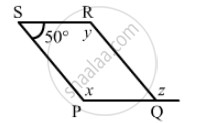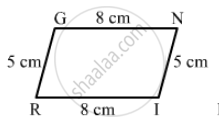Advertisements
Advertisements
Question
The following figure is parallelogram. Find the degree values of the unknown x, y, z.

Solution
\[\text{ Opposite angles of a parallelogram are same } . \]
\[ \therefore x = y \text{ and } \angle RQP = 100°\]
\[\angle PSR + \angle SRQ = 180°\]
\[y + 50°= 180°\]
\[x = 180°- 50°\]
\[x = 130°\]
\[ \therefore x = 130°, y = 130° \]
\[ \text{ Since y and z are alternate angles, z }= 130° . \]
APPEARS IN
RELATED QUESTIONS
Can the following figure be parallelogram. Justify your answer.

Fill in the blank, in the following, so as to make the statement true:
A rhombus is a parallelogram in which ......
The diagonals of a parallelogram are not perpendicular. Is it a rhombus? Why or why not?
Construct a rhombus whose diagonals are of length 10 cm and 6 cm.
One side of a rhombus is of length 4 cm and the length of an altitude is 3.2 cm. Draw the rhombus.
Lengths of diagonals of a rhombus ABCD are 16 cm and 12 cm. Find the side and perimeter of the rhombus.
Measure of one angle of a rhombus is 50°, find the measures of remaining three angles.
The lengths of the diagonals of a Rhombus are 12 cm and 16 cm. Find the side of the rhombus
If a diagonal of a quadrilateral bisects both the angles, then it is a ______.
If all sides of a quadrilateral are equal, it is a ______.
